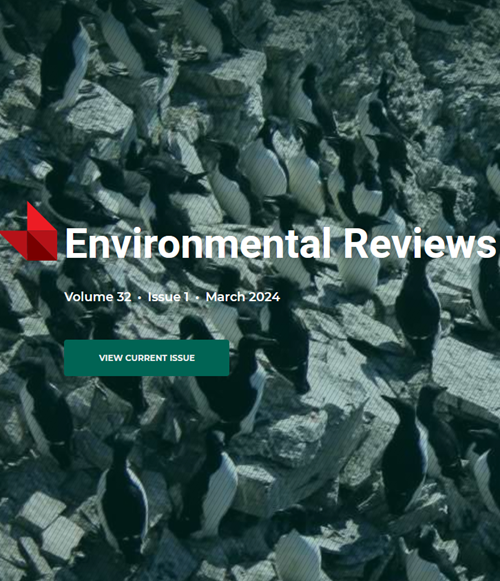绿色浪潮:入侵的欧洲绿蟹(Carcinus maenas)的环境影响和潜在的管理方法
IF 5.1
3区 环境科学与生态学
Q2 ENVIRONMENTAL SCIENCES
引用次数: 10
摘要
欧洲青蟹(Carcinus maenas)原产于欧洲西北部和非洲,是全球100种最具破坏性的入侵物种之一。在包括北美洲大西洋海岸在内的一些地区,C.maenas已经导致鳗草栖息地以及双壳类、螃蟹和鳍鱼种群的长期退化,而这些地区正接近入侵周期的开始。由于C.maenas种群的高持久性和繁殖潜力,大多数地方和区域缓解工作不再致力于灭绝,而是专注于种群控制。长期监测和快速反应协议有助于早期发现引入,这对管理层做出与青蟹控制或根除相关的决策至关重要。一旦发现C.maenas,当地管理人员将需要决定管理行动,包括是否以及将采取何种青蟹控制措施,是否可以防止或根除当地入侵,以及是否可以减少人口以实现功能性根除。由于灭绝马齿苋种群可能需要巨大的行动需求,再加上监测和清除资源有限,任何一个政府、保护和/或学术组织都不太可能充分控制或灭绝当地的种群,这突出了合作努力的重要性。基于社区的监测,以及环境DNA(eDNA)等新兴方法,可能有助于扩大监测的空间和时间范围,促进C.maenas的早期检测和清除。虽然一些清除C.maenas的项目已经成功地减少了它们的数量,但据我们所知,还没有任何项目成功地消灭了入侵者;从长远来看,任何此类项目的成本都可能是巨大且不可持续的。另一种方法是功能性根除,即将C.maenas种群减少到阈值水平以下,从而将生态系统影响降至最低。与根除相比,实现和保持功能性根除可能需要更少的资金和努力。在任何一种情况下,都需要持续的控制工作,因为C.maenas的种群可以从低密度和幼虫重新引入中迅速增加。本文章由计算机程序翻译,如有差异,请以英文原文为准。
The Green Wave: Reviewing the Environmental Impacts of the Invasive European Green Crab (Carcinus maenas) and Potential Management Approaches
The European green crab (Carcinus maenas), native to northwestern Europe and Africa, is among the top 100 most damaging invasive species globally. In some regions, including the Atlantic coast of North America, C. maenas has caused long-term degradation of eelgrass habitats and bivalve, crab, and finfish populations, while areas are near the beginning of the invasion cycle. Due to high persistence and reproductive potential of C. maenas populations, most local and regional mitigation efforts no longer strive for extirpation and instead focus on population control. Long-term monitoring and rapid response protocols can facilitate early detection of introductions that is critical to inform management decisions related to green crab control or extirpation. Once C. maenas are detected, local area managers will need to decide on management actions, including whether and what green crab control measures will be implemented, if local invasion might be prevented or extirpated, and if population reduction to achieve functional eradication is achievable. Due to the immense operational demands likely required to extirpate C. maenas populations, combined with limited resources for monitoring and removal, it is unlikely that any single government, conservation and/or academic organization would be positioned to adequately control or extirpate populations in local areas, highlighting the importance of collaborative efforts. Community-based monitoring, and emerging methods such as environmental DNA (eDNA), may help expand the spatial and temporal extent of monitoring, facilitating early detection and removal of C. maenas. While several C. maenas removal programs have succeeded in reducing their populations, to our knowledge, no program has yet successfully extirpated the invader; and the cost of any such program would likely be immense and unsustainable over the long-term. An alternative approach is functional eradication, whereby C. maenas populations are reduced below threshold levels such that ecosystem impacts are minimized. Less funding and effort would likely be required to achieve and maintain functional eradication compared to extirpation. In either case, continual control efforts will be required as C. maenas populations can quickly increase from low densities and larval re-introductions.
求助全文
通过发布文献求助,成功后即可免费获取论文全文。
去求助
来源期刊

Environmental Reviews
环境科学-环境科学
自引率
3.50%
发文量
45
期刊介绍:
Published since 1993, Environmental Reviews is a quarterly journal that presents authoritative literature reviews on a wide range of environmental science and associated environmental studies topics, with emphasis on the effects on and response of both natural and manmade ecosystems to anthropogenic stress. The authorship and scope are international, with critical literature reviews submitted and invited on such topics as sustainability, water supply management, climate change, harvesting impacts, acid rain, pesticide use, lake acidification, air and marine pollution, oil and gas development, biological control, food chain biomagnification, rehabilitation of polluted aquatic systems, erosion, forestry, bio-indicators of environmental stress, conservation of biodiversity, and many other environmental issues.
 求助内容:
求助内容: 应助结果提醒方式:
应助结果提醒方式:


